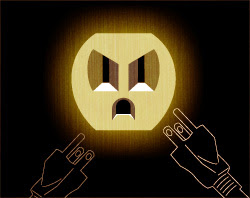Put a Stake In It

By Brianne McCleary
Rebecca Clarren wrote an interesting post on Vampire Energy for Salon.com in January of 2008. The full article can be found here but I will summarize the main points below.
- Half of our appliances, including microwave ovens, computers, TVs, electronic equipment and associated chargers that suck down power even when they're turned off, in sleep or standby mode.
- A typical house hosts around 50 such insomniacs, and though individual devices use minuscule amounts of electricity, in the aggregate they're an astonishing and pricey burden.
- This "vampire energy loss" represents between 5 and 8 percent of a single family home's total electricity use per year, according to the Department of Energy. On average, that's the equivalent of one month's electricity bill.
- Taken across the United States, this adds up to at least 68 billion kilowatt-hours of electricity annually; that's the equivalent output of 37 typical electricity-generating power plants, costing consumers more than $7 billion.
- This wasted energy sends more than 97 billion pounds of carbon dioxide into the atmosphere; on a global scale, standby energy accounts for 1 percent of the world's carbon emissions, according to Alan Meier of the Lawrence Berkeley National Laboratory, based in California.
"When a consumer thinks the device is off, it should be using as little power as possible," says Meier. "But in their haste to get products onto the market, manufacturers don't make those modest design improvements, and we, the consumers, pay the price in unnecessarily high standby power use."
New gadgets that can help
- Smart Strip. By monitoring power consumption, the strip detects when computers or stereos are off and powers down, eliminating energy usage in all peripheral devices such as printers.- Isolé power strip, which uses a motion sensor to turn off six of its eight outlets if it hasn't detected anyone in the room for up to 30 minutes.
- Kill a Watt power meter, a nifty gadget with a wall outlet that measures the watts, volts, amps and kilowatt-hours of a given device when off or on.
- Energy Detective. Measures whole-house electricity consumption. It costs around $190 and provides cost estimates of energy use and greenhouse gas emissions. Like a scale, it doesn't help you lose weight or cut back on power. But by providing immediate feedback of how much money you are spending each day on energy, and how much you are likely to spend next month, it's a solid motivator to unplug appliances and turn off lights. Consumers who used such monitors cut back their energy use by around 5 percent, according to a July 2007 report by the American Council for an Energy-Efficient Economy.
A dual responsibility
A major solution to vampire energy, say experts like Meier, will arrive when manufacturers design more efficient appliances. Even so, by using power strips and maintaining vigilance about unplugging the TV and devices that get little use, we can help save energy and put a stake through these energy vampires.

Comments
Post a Comment
Let your knowledge, ideas, and innovation be heard. Tell us what you think and know about this topic.